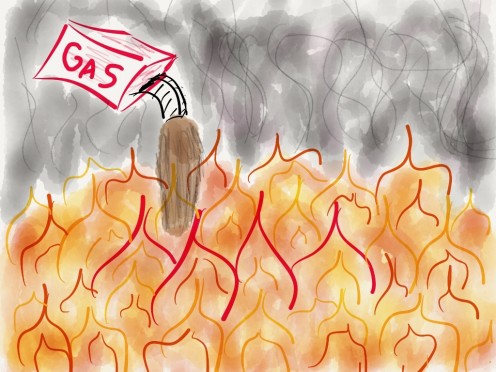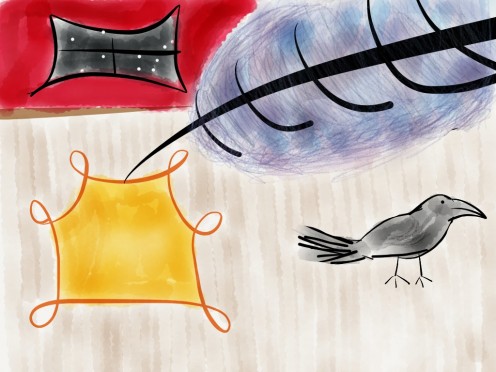Advanced Alternatives to Rhyme for Poetry
Set Your Poetry on Fire!

The Importance of Devices
Rhyme is used by many professional and amateur poets. Unfortunately, rhyme is an easy device for inexperienced writers to rely on too much. A reader easily picks up on rhyme and is easily able to "feel" the poem. This is one reason many writers think they need to use rhyme in every poem--to make an immediate connection to the reader. It is a way to shout, "Hey, this is a poem."
This leads to forced rhymes, poor diction and irregular syntax. I go into more detail about this in my hub that explains why poetry does not need to rhyme. In a second hub, I discuss alternatives to rhyme for poetry. There are many other devices that give poems depth and meaning. The first article about alternative devices drovers the more basic poetic devices such as consonance, assonance, onomatopoeia, metaphor and simile among others. This hub gives an overview of some of the more advanced poetic devices.
Famous Poets
Of those listed, who is your favorite poet?
Have Specific Reasons
It is worth noting that each literary device serves a different purpose. It is not advised to use all of these devices in one poem. Rather, you should choose which ones best suit your subject and take the time to develop those thoroughly.
This means that you must take time to carefully decide which devices you want to use and why those are important to your piece.
Why have you chosen this particular device for this part of the poem?
You must have a clear answer to this question while you write. Each device serves a purpose, and it is your responsibility to ensure that each device works well.
What Are You Doing?
Each poetic device serves a specific purpose. Make sure that you have a good reason for using each device in their respective locations within your poem.
Internal Rhyme
If you really love rhyme, you have another option besides rhyming at the ends of lines. Internal rhymes create some wonderful sounds and are useful in many situations. With internal rhyme, a word inside a line rhymes with another word on the same line.
"Once upon a midnight dreary, while I pondered weak and weary."
-"The Raven"
Edgar Allan Poe
- The rhyme of dreary and weary within one line of poetry creates internal rhyme.
That Darn Raven!

Wretched Rhyme
A wretched rhyme is a bit different than a light rhyme; however it still relates to the stressing of syllables. This is a rhyme of a stressed syllable with an unstressed syllable.
- For example, lady / a bee
- In the above example, the bold in the words shows the rhyming stressed syllable in lady and the rhyming unstressed syllable in bee.
- Lady has the first syllable stressed and bee has its only syllable unstressed. These rhyme and create the wretched rhyme.
Light Rhyme
A light rhyme is produced when a stressed syllable is rhymed with a secondary stressed syllable.
- For example, frog and dialogue. Another example is live and prohibitive.
- In the examples above, the bold shows the stressed, rhyming syllables of each word.
- -logue and -tive are secondary syllables of multisyllabic words and are stressed syllables. Frog and live are the primary syllables of monosyllabic words and are also stressed syllables.
Elision
Elision might be rather familiar to you. You may have seen it in poems or songs, because it can be very important. Elision is used when a poet deletes an unstressed vowel or syllable in order to retain the proper meter of a line of poetry.
Shakespeare wrote his plays mostly in iambic pentameter-an extremely difficult task. He relied on elision in many instances to keep true to the meter.
- For example, in W.H. Auden's poem, "In Memory of William Butler Yeats", he writes
"Flies o'er th' unbending corn..."
- The apostrophes delete letters and syllables to retain meter and create elision.
Take Your Time!
You must take your time and practice developing your skills with poetic devices. Just learning them is not good enough. Hone your skills. Find which ones you like best and do well. Practice, practice, practice. When you find your rhythm, you will feel it and become more confident in your writing. This will show in your poetry.
Feminine Rhyme
In my hub about alternatives to rhyme for poetry, one device I discuss is consonance. The feminine rhyme relies on this device. This happens when consonance appears on the final consonants of the words involved.
- For example, the words ill and shell create a feminine rhyme.
- The consonance that occurs on the last consonant sounds, ill and shell, create the feminine rhyme.
Syntax
Syntax is the order in which the parts of a sentence is put together. Normal syntax for a basic sentence is SUBJECT-->VERB-->OBJECT.
For various reasons, poets invert this format. This can be done with any type of sentence, not just a simple one.
- Whose shoes these are I think I know.
- The sample sentence has an inverted structure, as it does not follow the normal flow of SUBJECT-->VERB-->OBJECT.
Extended Metaphor
An extended metaphor is exactly what it sounds like. It is a metaphor, but it not like the usual metaphor. An example of regular metaphor might be, "Her body was a statue." This is only one sentence. An extended metaphor takes up multiple lines of poetry to develop. Some extended metaphors last for the entire work.
Emily Dickinson uses an extended metaphor in "Hope Is a Little Bird"
Hope is the thing with feathers
That perches in the soul,
And sings the tune--without the words,
And never stops at all,
And sweetest in the gale is heard;
And sore must be the storm
That could abash the little bird
That kept so many warm.
Don't Over Do It
Just because you are learning many new poetic devices does not mean you have to jam all of them into one poem. Take your time to judge which ones work best for each poem.
Mixed Metaphor
Be careful. Mixed metaphors are horrible. They are poorly written and twisted pieces of ideas. They sometimes mix two unrelated cliches.
- Tom Wolf in The Bonfire of the Vanities writes
"All at once he was alone in this noisy hive with no place to roost."
- This awkwardly mixes two cliches.
Implied Metaphor
An implied metaphor is one that is only hinted at. It does not stand out in plain view.
- For example, "Shut your trap!"
- The implied metaphor is that your mouth is a trap.
Refrain
The refrain is used to place an emphasis on a word or phrase. You may be familiar with the use of the word refrain as a musical term. It works the same way in poetry.
The refrain is the repetition of a word or phrase throughout a poem to provide emphasis of that idea.
- For example, in Edgar Allan Poe's "The Raven", he uses one of literature's most famous refrains.
"Quoth the raven, 'Nevermore'"
Idiom
Another term with which you may be familiar is the idiom. These are phases where the literal meanings of them are not what is meant by the speaker. The expressions mean something different than what they literally mean.
- For example, "The ball is in your court."
- We are not playing a game. There is no physical ball or court.
- This figuratively means that it is up to you to make a decision.
Idiom

Keep Writing
As you continue to discover new poetic devices, you will begin to find which ones you enjoy most and which ones you are best at producing. It takes a lot of time and effort to compose a poem with valuable devices. You first need to hone your skills for each device you wish to use in your poems; that takes practice and patience. The best way to do that is to start writing and keep writing.
Hopefully some of these poetic devices come in handy. Take a look at famous, well written poetry to understand what good poetry is and see devices used well. Seeing good work is always helpful when trying to figure out how to produce your own.








